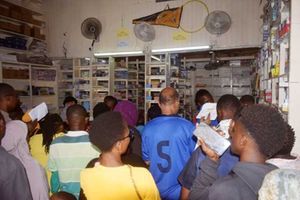
Parents, guardians and students queue during the admission of Form One students at Kenya High School in Nairobi on January 15, 2024.
In 1986, 16-year-old Sospeter Okusah walked through the gates of Agoro Sare High School with a mixture of expectations.
Before his Form One admission to the prestigious schools of that time, he had sat his Kenya Certificate of Primary Education (KCPE) Examinations at Arina Primary School.
Mr Okusah was part of the pioneer 8-4-4 class which was examined in 1985 and also the first to join Form One in 1986 after the new system replaced the 7-4-2-3 one.
The 8-4-4 curriculum was introduced in Kenya in 1985 by former President Daniel Arap Moi as a response to the changing global and economic landscape.
The system, which attracted praise and criticism in equal measure, was introduced by the Presidential Working Party of the Second University in Kenya.
But as a ‘mono’, as they were referred to by the senior learners, he was somehow fearful of his stay at Agoro Sare High School following the dark tales of bullying that had clouded his mind following stories told by his elder brother and other senior students.
New admissions
“I was somehow prepared, having been told about bullying of the new students. It was the usual harassment like being forced to sing, call home using a shoe and being called a Mono. But generally, the experience was not as bad as I had feared, we ended up coping well,” recalls Mr Okusah.
But on the flip side, he was excited at being part of the pioneer Form 1 class, with new items including uniforms.
He was also thrilled to learn in a new institution, which was 89.5 kilometres away from home, and enjoyed the adventure of a two-hour drive to school for four years.
He also remembers how the senior students were way older than them, with almost four or five years of age difference between them.
When it came to the items they took to school, Mr Okusah said back then, the school management was liberal and Form One students could be admitted with cooked food, blue band, and sugar among others, but with time, schools started controlling and banning the shopping to bring some form of equality among students.
For the 54-year-old who has managed to see the transition to date, the experiences of nearly all Form One students are the same but the level of bullying has reduced owing to the reforms in the education sector.
“There have been a lot of transformations in laws and policies that protect new students from bullying. We now have more mature students, who know their rights and friendlier teachers, this has changed things,” said Mr Okusah.
But January 2025 is now seeing secondary schools without Form One as they embrace another new education curriculum— the Competency-Based Curriculum (CBC).
As congestion, confusion and teacher shortages marked the rollout of Grade 9, with more than one million learners of the pioneer CBC class reporting to school, secondary schools started life without form ones.
Who would have known that one day, the so-called ‘Monos’ derived from the word ‘One’, would be missed this much and the huge impact it would have on education?
Their absence appears to have had a ripple effect across many sectors.
Today, the streets of Kisumu would have been filled with parents with heavy loads, and students with fresh-paint-smelling-metallic boxes hopping from one shop to another to buy various items required during admission.
Businesses would now be booming in every town from uniform sellers, book and stationery shops, branding shops, banks, and supermarkets to the transport sector which played a big role in ensuring that the new students reported without a hitch.
But this is not the case. The town is quieter, with fewer parents dealing with back-to-school requirements as is the norm when schools reopen.
Branding uniforms
For Mr Erick Yimbo Hosea, Director at Blackberry Uniforms Enterprises, the business has gone down following the end of Form One class.
“At a time like this, parents of Form Ones usually buy the bulk of items. We usually report high sales since the number of uniforms— which included tracksuits, sweaters, and games kits — would be high. This is not the case this year,” said Mr Yimbo.
When Nation.Africa visited the shop, artisans who are usually located outside offering various services such as branding of uniforms were missing.
“We have many people branding uniforms outside here, inscribing names on various items for the students. For any piece of clothing, they used to charge Sh50, you can imagine what they would make on 20 items per student and what they are losing now,” said Mr Yimbo.
In the schools, there used to be some excitement when new students reported.
Senior students would pick their ‘school sons’ from Form One students, and this would come with some benefits, like shopping in exchange for some form of protection from senior learners.
During the admission of new students, businesses around the schools would boom with many makeshift eateries selling food and refreshments.
Now the schools that lit up the rural areas have remained quiet, with teachers focusing on the senior students.
“During admission, most teachers would be deployed to help in one way or another in registration of the Form Ones. This would eat up almost one week of lessons. But now teaching resumed immediately in other classes from week one,” said a teacher from a school in Kisumu’s Seme sub-County.
The impact of the absence of Form One students is felt by secondary schools in terms of reduced capitation and enrolment.
Mr Zablon Awange, the Executive Secretary of the Kenya Union of Post Primary Education Teachers (Kuppet), Kisumu County branch, terms the current situation as the same as in 1984 when CPE was abolished and Class Seven pupils proceeded to Class Eight in the new 8- 4 - 4 system.
He feels the current situation of transition to CBC where junior secondary has been domiciled in primary institutions has caused new challenges.
“Capitation, a new phenomenon, has been used by primary and secondary schools to build infrastructure, pay wages and general operations leading to massive growth of schools and access to education. Domiciling JSS in primary, transfers a sizable amount of capitation to the heads of institutions,” said Mr Awange.
Mr Awange pointed out that primary schools need new classrooms to accommodate the new learners but on the ground, the majority are only three-quarters complete or work is in progress. This means many JSS students will learn under trees.
“As Kuppet, we foresaw this and in a bid to alleviate budgetary constraints, we proposed that Grade 9 be domiciled in empty Form One classrooms,” said Mr Awange.
With no students to occupy them, many schools are stuck with the many unoccupied classrooms.
Some schools, especially the national learning institutions, used to have between eight and 10 Form One streams.
The workforce has also reduced— with tutors employed by the school Board of Management being the first casualties because of reduced lessons.
“Many schools laid off BOM teachers in anticipation of reduced workload. In December, the Teachers Service Commission also made numerous changes and transfers and we are told it is already causing anxiety among teachers who might be moved to remote areas to balance this,” said Mr Awange.
The Kuppet official pointed out that the challenges faced by secondary schools led to many extra county and national schools issuing circulars last term advertising for new bright students for interviews to fill Forms Two, Three and Four complete with an interview fee of Sh1, 000 to improve their mean.
“Some also did this under the guise of football volleyball, basketball and hockey talent search, among other extra-curricular activities. This affected sub-county schools because many students were eager to join established institutions that had earlier denied them Form One chances due to congestion,” said Mr Awange.
The Ministry of Education did pronounce itself on this but damage had already been done to sub-county schools.
“We still insist that Grade 9 students should be allowed to report to the nearest sub-county senior secondary schools as early as second term to fully utilise the human resources and physical infrastructures,” said Mr Awange.
Kuppet says the transition must be managed effectively if CBC is to succeed. The union blames the challenges and confusion on the government ignoring expert advice from educationists.











